- History and Science, seemingly at two
ends of the spectrum, when studied together, provide us with brilliant insights.
This article explores geographical events mentioned in ancient historical texts
and now proven by science.
The vast landscape of Ladakh Himalaya is a wonder in
itself. The barren desert, laced with even barren mountains reaching the sky,
with a background of even higher mountains covered in snow! The green bushes
and poplars give a respite to the eyes along with pristine blue ribbons of celestial
rivers. And in that cold desert, you do find the bluest of the blue lakes
gleaming in moonlight and morning sun.
 Pangong Lake, Ladakh. Pic by author.
Pangong Lake, Ladakh. Pic by author.
But the water is salty. And on the ground, you are
guaranteed to find shells and cones. Are we on a seashore? Actually, we are standing on a sea shore whose waves stopped lapping
millions of years ago. Modern scientific discoveries tell us that the Himalaya
Mountain range is formed due to collision of two plates and shrinking of the
sea and lifting up of the seabed.
The Indian subcontinent has several such mysteries and
moments tucked away in its geographical expanse. This geography is home to
millions of people too.
Children of this homeland nurtured a continuous civilization
which flourished over several millennia. Not surprisingly, the oral and written
histories, legends and mythologies of India are humongous. Thankfully, our
ancestors painstakingly noted the dynasties, events, wars and also geography,
seasons, natural calamities and astronomical data.
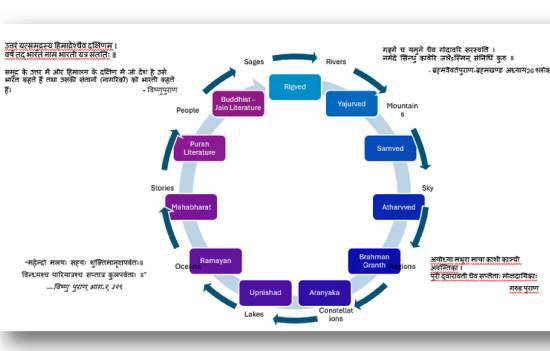 Slide by author.
Slide by author.
There are many memories in our historical literature
which can now be verified with research using science and technology. History
and Science, seemingly at two ends of the spectrum, when studied together, provide
us with brilliant insights about us Humans and their surroundings. Scientific research
in the last few decades confirms what was traditionally known to Indians, as
part of Sanatan Hindu scriptures.
Dwarka of Shrikrishna
Land of Saurashtra in western India, nearing Arabian
Sea is sacred because of presence of Dwarka,
a city established by Shrikrishna according to Mahabharat.
As of now, based on traditions, we find two locations
for Dwarka. One is in western Saurashtra near Gulf of Kutch, and the adjoining
island is known as Bet Dwarka. The Other Dwarka is in southeast Saurashtra and
is known as Mool Dwarka near the town of Kodinar. Bet Dwarka is also known by
its ancient name of Shankhodhar, and island in
shape of Konch.
Now the marine excavations were done at both places,
near Bet Dwaraka and Mool Dwarka. Both excavations have exhibited continuous
settlement for thousands of years. The artefacts found in the sea include, well
cut stone slabs, stone holes as anchors and circular stone structures which
could be pillar bases. These discoveries from 1980 onwards tell us about part
of Indian subcontinent which is submerged now but was once a thriving city.
Rising sea levels in last few millennia must have covered the ground which was
once part of human settlement. 1
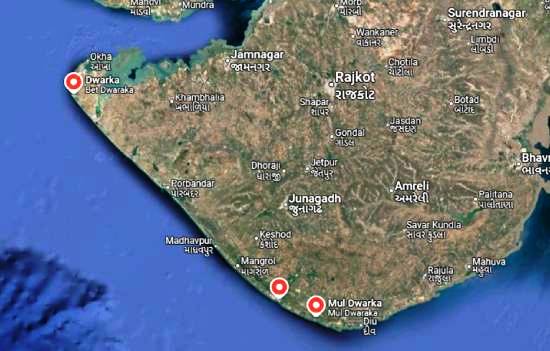 Three possible locations of
Dwarka. Courtesy Google Earth.
Three possible locations of
Dwarka. Courtesy Google Earth.
This brings us to the memory recorded in Mahabharat,
Harivansha and Bhagvat Puran. Harivansha and also other Puranas tell us about a
once beautiful but now ruined city of Kushsthali near the western sea in the
vicinity of Raivatak mountain. Shri Krishna decided to establish Dwaravati or
Dwarka at the location of Kushsthali and in addition, asked the Sea lord to
give away some more land. The Sea obliged and Dwarka, one of the most beautiful
cities, was built on recovered land as well.
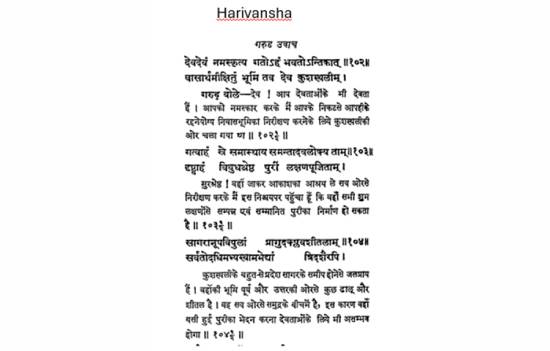 Harivansha.
Harivansha.
As mentioned in Mahabharat, after a few years, the sea engulfed and swallowed Dwarka. The description in Mahabharat is a matter of fact! Krishna’s Dwarka was captured by sea in front of the eyes of Dwarka citizens who were led by Arjuna to evacuate the city as per Shri Krishna’s orders.
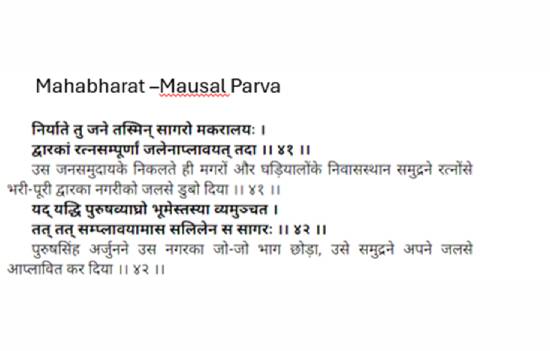 Mahabharat – Mausal Parva.
Mahabharat – Mausal Parva.
Some experts have pointed out that this Dwarka could
be near Prabhas teerth near Somnath, in which case that could be probable third
location of Dwarka.
In any case, the Coast of Saurashtra, when explored with marine archeology, has given ample proof of settlements dating to second or third millennia before today which are submerged now. This coincides with the description of sea capturing the Dwarka which was a costal island as per scriptures. This could be result of massive Tsunami or rising sea levels. 6
Hastinapur of Kaurav and Pandav
Hastinapur was the capital of Kurus as mentioned in Mahabharata. It is on the
banks of Ganga River. Vayu Puran and Matsya Puran mention that Hastinapur had
to face floods and hence the capital was shifted to Kosambi during the reign of
Nichakshu, the fourth Kuru king after Janmejay.
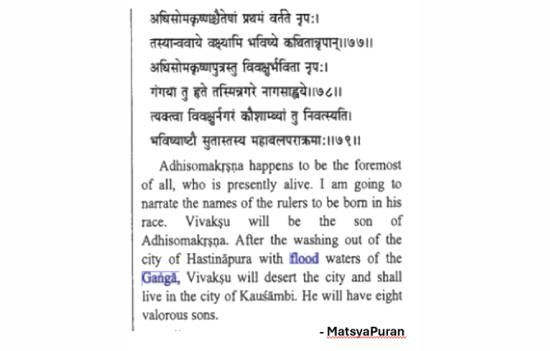 Matsya Puran.
Matsya Puran.
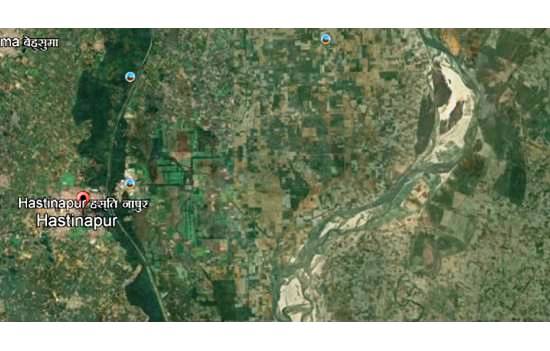 Hastinapur location and Ganga river. Credit Google Earth.
Hastinapur location and Ganga river. Credit Google Earth.
Now let us see what scientific discoveries tell us.
Hastinapur even today is on the banks of Ganga River
in northwestern Uttar Pradesh. A channel of Ganga close by is known is Budhi Ganga
which could be original bed of Ganga River in ancient years. Archeologists have
carried out a lot of excavation work at Hastinapur since 1950. Dr B B Lal, one
of the renowned archeologists, is credited with the extensive excavation of
layers at Hastinapur. The archeological evidence suggests a gap in settlements.
There is also evidence of Ganga flood water in the soil found between two
settlement layers. This relates well with what Mahabharat told us years back. 2
Saraswati River
Mahabharat also tells us about drying up of the river
Saraswati. We have known Saraswati River since Rigveda, the oldest of the texts that mentions Saraswati was the largest and grandest of the rivers. Saraswati flows from mountains to the sea, and we also know of several ‘Teerth’ on its bank. However today, we do not see the Saraswati flowing where it was supposed to flow which is Haryana, Rajasthan and Gujrat. Instead, we see the desert of Thar and water strapped land of Gujarat.
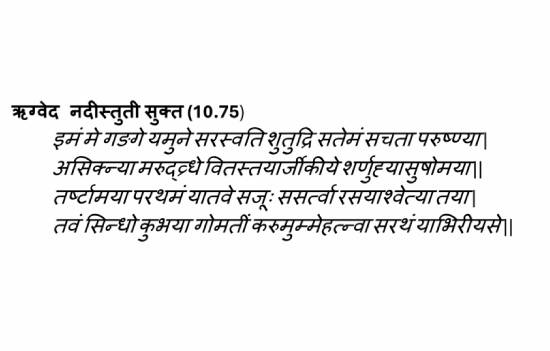 Rigved
Rigved
The scientific discoveries in the last century have
proven that part of present-day Rajasthan is covered in paleochannels (water-soaked
tracks of underground soil, visible through satellite imaging). 3 There have been other discoveries which conclude that there must have been a large Himalayan River flowing through this part of northwestern India and reaching Arabian Sea. The dates of ‘Grand Saraswati’ are varying depending on research papers. However, denial of the existence of Saraswati River in Indian geography is no more possible. 4
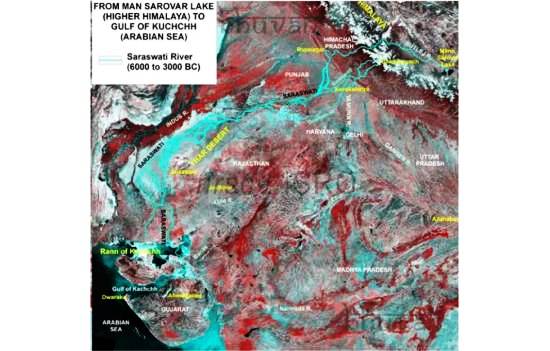 Satellite Image of Saraswati Paleochannels. Source
Satellite Image of Saraswati Paleochannels. Source
Now back to Mahabharata, where the ‘’Itihas’’ mentions about Vinashan, a place where Saraswati has vanished. Not only that, Mahabharat mentions about the reappearance of Saraswati at some places on its course. Balaram, Shri Krishna’s brother traverses the Saraswati as part of Parikrama and Mahabharat text brings information about several places /Teerths on Saraswati River.
9 Teerth on Saraswati river. Courtesy Google Earth.
Matsya Puran has a story about Saraswati river being
given a task to carry the fierce Vadavanal, the Mega Fire into the western sea.
Due to this Saraswati went underground carrying the mighty fire. The task
itself may indicate, drying up of Saraswati.
The later discoveries have also inferred that Sutluj
and Yamuna were the primary tributaries of Saraswati. Due to tectonic
movements, these rivers turned away and that impacted Saraswati waters to a
large extent. May be Triveni Sangam at Prayag which includes Saraswati brings
us the cultural memory of Saraswati whose water is now captured by Yamuna and
brought to Ganga!
Kashmir - Satisar and Satidesh
Kashmir, the sacred land of Kashyap Rishi and Shaiva philosophy has one of most
intriguing stories to tell.
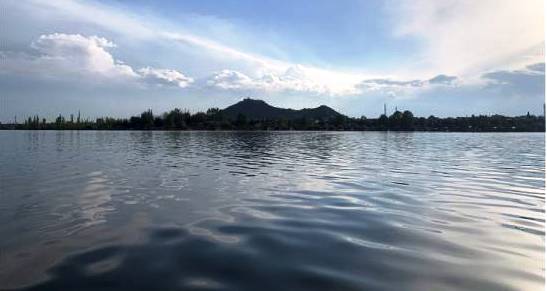 Dal Lake, Srinagar. Pic by Author.
Dal Lake, Srinagar. Pic by Author.
The valley of Kashmir, surrounded by Himalayan Mountain peaks was once a massive lake. Scientists have discovered ‘Karewa’, the local name of flat elevated land, show soil deposits of lakebed and glacial feed. Also, the direction of Karewas slope is in particular direction denoting the flow of water. It is worthwhile to note that land in the valley has a lot of water content and it is very fertile owing to the fact that it was once a lakebed.
A huge lake that was tilted northward,
eventually found an opening at Baramulla or Varahmul as known to ancient
Indians, on the western wall and drained, also forming Vitasta to carve its
course out of the valley. The discovery tells us that this event must have
happened 85,000 years before present. 5
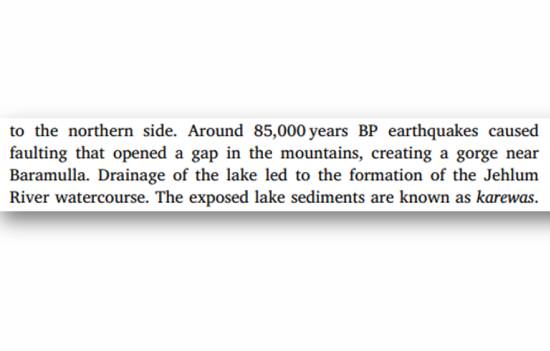
What is surprising is that this
scientific discovery is corroborated by an ancient text called Neelmat Puran, also
known as Sthal-Puran or location-history of Kashmir. As per the Puranic verses, Satisar was the
big lake occupying the Sati-Desh, which is Kashmir Valley for as long as five
Manvantar.
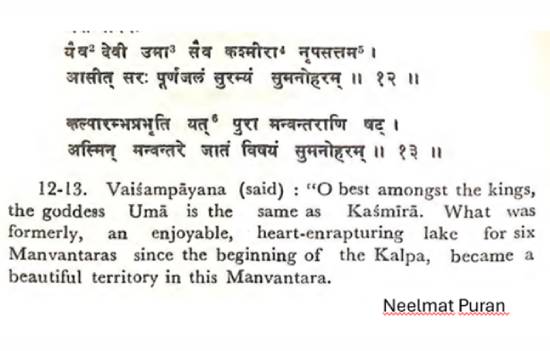 Neelmat Puran.
Neelmat Puran.
Rishi Kashyap drained the lake and
Jalodbhav, the water born Asur dwelling inside and troubling all, was killed. The
lake was drained by destroying the mountain wall and creating an opening at
Varahmool, one which looks like the mouth of a wild boar, another incarnation
of Bhagwan Vishnu. The lake was drained, the demon was demolished, and the land
formed was inhabited by people and Nag families, supposed to be original
inhabitants.
There is a reason why we
find several place names postfixed with Nag in Kashmir
like, Anantnag, Verinag etc. Also, we find several lakes in the valley,
such as Wular, Manasbal and Dal Lake, probably remnants of the original mega
lake.
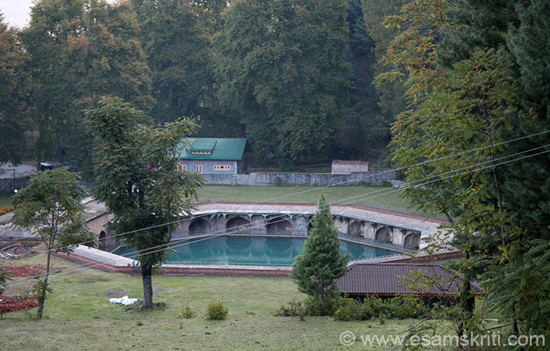 Kund at Verinag in Kashmir i.e. the source of the river Jhelum.
Kund at Verinag in Kashmir i.e. the source of the river Jhelum.
Now, how did the Nilmat Puran describe
an event which might have geologically occurred 85,000 years ago!
There are many such hidden truths or insights in our
ancient texts. The story of floods which drowned the entire world and
threatened the existence of the living world is also there in all cultures. We
have Manu as the survivor and protector and his boat whereas in Bible, there is
Noah and its arc!
Apart from geophysical events there are many such
astronomical and even sociological events recorded in various scriptures and
texts which provide us with a more informed glimpse of our past.
If we corroborate them with scientific discoveries of recent
times they throw open a wide range of possibilities regarding the course of
history as we know.
References
1. Nodc.noaa.gov
2. Worldwidejournals.com
3. Satellite image-based mapping of the
Saraswati-Drishadvati palaeochannel system was carried out by Ghose et al.
(1979).
4. The Lost Saraswati River of Northwestern Indian Plains: Status and way forward - by H.S.Saini 1 , Apurva Alok2 , N.C. Pant2 – Critical examination of Saraswati Paleochannels ( 2019)
5. The Northern Neolithic of the Western Himalayas: New Research in the Kashmir Valley Alison Bettsa , Mumtaz Yatoob , Michael Spatea,⁎ , James Fraserc , Zahoor Kalood , Younus Rashide , Anil Pokhariaf , Guilin Zhang
6. Geoscienceletters.com
Author Manisha Chitale has been a lifelong student of India's culture, history and has travelled extensively to follow her passions. She has tried to strike a delicate balance between pursuing these interests and her day job in Senior Manager in an Information Technology company.